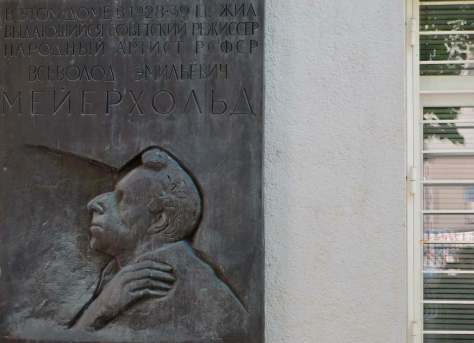Click on photos to enlarge.
I am always taken aback when I encounter this building at 6 Leontyevsky Lane. This is where Konstantin Stanislavsky lived from 1921 until his death in 1938. He is identified on one of the plaques on the front wall as an “actor and director.” Nowhere does it say that he was a co-founder of the Moscow Art Theater, but maybe that would be superfluous. A little bit like labeling the summer sky blue. Soviet scholars, armchair or otherwise, will immediately note the curiosity of the date: 1921. This is when the Russian Civil War was still underway. Muscovites of all walks and professions at this time were being forced to give up their individual apartments as strangers, sometimes couth, sometimes un-, were moved into “spare” rooms. The word in Russian was ‘uplotnenie,’ that is, ‘packing-them-in.’ If you had a three-room apartment you could expect the state to move in at least two other families into the ‘extra’ rooms. It was the way the young Soviet government solved the housing crisis. What does this have to do with Stanislavsky’s home? Well, look at it. It’s huge. And it all belonged to Stanislavsky. I haven’t made it a point to study this topic, but the only other person I know of who received this kind of treatment was Maxim Gorky, to whom Stalin, in 1932, gifted a spectacular art-moderne home on Spiridonivka across from the church where Alexander Pushkin was married.
This building that was put at the service of Stanislavsky has quite a history. Parts of it were erected between 1650 and 1670. It was expanded in or around 1777, and then again at the beginning of the 19th century. There are not many buildings left in Moscow that are that old. Fires and wars have seen to that. And most of the ones left are not residential structures. So this is really something. It is kept in beautiful condition, as you can see. The powder yellow is one of my favorite colors in Moscow. The first two photos in the block immediately below show the structure from the inside courtyard. The second photo, which looks out the gate at the building across the street, shows how well the powder yellow combines with another of Moscow’s common colors – powder blue.
Russian Wikipedia tells us that just a few doors down from here, at 2a Leontyevsky Lane stood the building in which Maria Lilina, Stanislavsky’s leading lady, lived before the couple was married. According to Moscow lore, it was there that Stanislavsky popped the question and Lilina accepted. I mention that building here because it can no longer be photographed or perused. It was torn down in 2003 to make way for a modern apartment building “with an underground garage,” as Wikipedia puts it.
The first year of Stanislavsky’s life in this home must have been hectic. As I have said, there was a Civil War raging all around. Not that bullets constantly flew freely in the skies over Moscow, but as a new book called The Soviet Theater: A Documentary History indicates, there were, indeed, days when bullets flew freely enough that the Art Theater had to think about canceling performances so as not to endanger actors and spectators. That, surely, is one of the reasons that Stanislavsky and a large group from the theater struck out on a world tour in 1922. They played in Europe and the U.S., although they were in the U.S. for much of the time between 1922 and 1924. If you know anything about human nature, you know full well that Stanislavsky was using that time to decide whether he should bother coming back at all. Many in Russia assumed that he and his troupe would not return. Just imagine Stanislavsky getting up in the morning somewhere in New York, Chicago or Philadelphia, sitting down to his orange juice and scrambled eggs that were served on a crisp, white linen tablecloth and thinking – “Do I go back? Do I not go back?” That quandary lasted for over two years. “Do I bail or do I not bail?” Meanwhile, the popularity of the Art Theater’s shows in the U.S. made Stanislavsky a god in the West. It was here that he wrote and published the first of his books which have come to be looked upon in theater circles as bibles.
In the end Stanislavsky did not bail, although not all of his actors returned with him. He returned to Moscow and his still-new home at 6 Leontyevsky Lane in 1924 at about the same time that his My Life in Art was published in English.
Long before moving into this home, Stanislavsky and Lilina had three children, two daughters and a son. The first daughter, born in 1890, died as an infant. The second, Kira (1891-1977), married the great painter Robert Falk and was the first director of the Stanislavsky House Museum when it was opened in this building in 1948 on the 10th anniversary of the great director’s death, and the 85th anniversary of his birth. Their youngest child, a son named Igor (1894-1974), married Alexandra Tolstaya, the granddaughter of Leo Tolstoy.
The museum displays the rooms in which Stanislavsky and his wife lived. There is a small auditorium which, on occasion, is used for performances by contemporary companies. Actually, I say that and then recall that it’s been years since I saw a show there. I did often attend performances there in the 1990s, but it’s been a long time since then…



























































